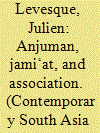|
|
|
Sort Order |
|
|
|
Items / Page
|
|
|
|
|
|
|
| Srl | Item |
| 1 |
ID:
193293


|
|
|
|
|
| Summary/Abstract |
In the early decades of the twentieth century in colonial India, the development of education, the expansion of electoral politics, and the decennial censuses led many caste communities, or ‘caste groups’, to organize collectively in search of internal solidarity and public assertion. Informed by the notions of service and reform, Muslims participated in this new associationism. Among them, the Sayyids – a privileged status group that claims descent from Prophet Muhammad – also formed their organizations. This article compares three Sayyid organizations in India and Pakistan, with two principal aims. First, it brings out the implicit notions of inclusion and exclusion that inform the functioning of the organizations as they seek community preservation. Second, it draws broader conclusions about associational forms available to South Asian Muslims when they act collectively on the basis of a shared social status or caste. The article concludes by delineating three ‘organizational models’ that Muslim caste groups can draw upon – the anjuman, the jami‘at, and the association. Overall, this article illustrates how Muslims frame practices of social distinction in an Islamic language of equality, piety, or service.
|
|
|
|
|
|
|
|
|
|
|
|
|
|
|
|
| 2 |
ID:
077670


|
|
|
|
|
| Publication |
2007.
|
| Summary/Abstract |
The failure of Japanese electronics firms to participate fully in the Internet-fueled growth of the global electronics industry during the late 1990s triggered a period of questioning among top executives. This article examines Japanese managerial responses to the organizational model "value chain modularity," which was deployed by the US electronics firms driving the creation of the Internet. While there were partial but significant steps taken in the direction of this new US model-increased specialization, outsourcing of low-end products, and shared factory investments in Japan -wholesale restructuring was resisted. This evidence is consistent with larger patterns of gradual institutional change in Japan . I argue that the result of this process will likely be increased, not diminished, institutional diversity over time. While globalization has accelerated the pace of change by opening new avenues for organizational experimentation and institutional layering, the drag on organizational change exerted by existing institutions slows the process enough to allow institutional and organizational innovations to develop into coherent systems with distinct characteristics. The result, inevitably, will be a uniquely Japanese approach to the challenges posed by globalization.
|
|
|
|
|
|
|
|
|
|
|
|
|
|
|
|
|
|
|
|
|